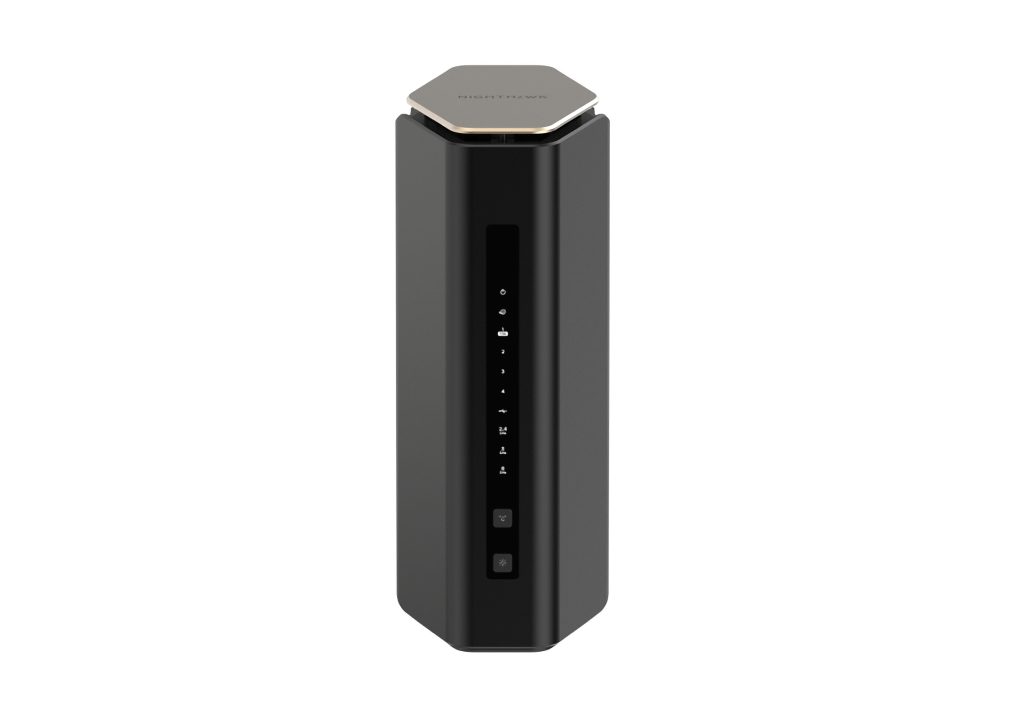The Netgear Nighthawk RS600 represents one of the initial models to feature WiFi 7 technology for home networks. While categorized as a mid-tier router within Netgear’s offerings, the RS600 excels at delivering high-speed wireless internet throughout your residence.
For Apple enthusiasts, the significance of WiFi 7 has become prominent with the release of the iPhone 16, the first devices from Apple to support this new standard. In this evaluation, we’ll explore the performance of the Netgear RS600 utilizing WiFi 7 in conjunction with the iPhone 16 Plus.
Design and Build Quality
The router exhibits excellent craftsmanship, with robust build quality reflective of its price range. High-performing routers typically boast external arrangements of protruding antennas to maximize speed and coverage. In contrast, the RS600 strikes a balance between aesthetics and functionality, presenting a sleek hexagonal design. This results in an attractive black obelisk shape that blends seamlessly into various home decors, which is essential since many users must display their routers prominently in living spaces.
Compact in size, the RS600 stands approximately 30 centimeters tall and 15 centimeters wide, taking up a footprint comparable to that of a large hardcover book. This size allowed me to discreetly place it within a corner media cabinet, significantly smaller than other WiFi 7 routers, such as the bulky Asus BE98, which occupies nearly double the space due to its extensive, outward-facing antennas. The RS600 not only fits neatly into my networking shelf but operates quietly as well, making its presence barely noticeable.
All input/output connections are located on the rear of the device, with ports arranged neatly in a vertical lineup. The front displays LED indicators corresponding to each port: white lights signify optimal usage, while orange indicates reduced performance. This feature allows for a quick visual check to ensure all Ethernet connections are properly configured. Unfortunately, I could not locate an option to disable the status lights if they prove distracting.

Setup and App Design
Setting up the Netgear Nighthawk RS600 via the app on an iPhone is a straightforward, almost plug-and-play experience. A simple wizard guides you through the process. During my setup, I encountered an error, which offered a chance to test the app’s handling of failures. It instructed me to power cycle the broadband modem, and after I followed those steps, the setup proceeded smoothly.
Since I was transitioning from an existing WiFi network, I quickly renamed the default SSID and password of the RS600 to match my previous router. This allowed all my devices to connect without needing to re-enter any network passwords. The app’s user interface simplifies this process, and for those seeking advanced adjustments, logging into the web control panel on a Mac provides that option.
While the app is functional, it is somewhat basic. It includes features like notifications to alert you when new devices connect to your network for the first time. Users can create device profiles as needed, but I opted not to take advantage of that feature.
One downside is the aggressive promotion of the optional Netgear Armor security subscription, which I found lacking in value given its cost. Although the subscription isn’t required, the app reminds you of its absence every time it opens with a red warning message. However, assuming everything is operational, frequent app access shouldn’t be necessary post-setup.
Wireless Connections with WiFi 7
WiFi 7 is the most recent iteration of the WiFi standard, offering considerably higher theoretical bandwidth and faster speeds for wireless devices. Its features include multi-link operation (MLO), which selects the optimal wireless channel to minimize interference. The WiFi 7 specification supports channels up to 320 MHz wide, double the maximum of 160 MHz found in WiFi 6E.
However, there is often a significant difference between theoretical and actual performance. Physical barriers such as walls, floors, and distance can greatly diminish expected speeds. Furthermore, there’s a discrepancy between what manufacturers promote and the realistic possibilities within the spec.
Currently, the only Apple devices that support WiFi 7 are in the iPhone 16 series. Though the RS600 can broadcast using 320 MHz channels, the iPhone 16 does not fully utilize this capability; it is limited to 160 MHz. Apple has been discreet about this fact, and it seems we will have to wait for future Apple hardware to fully exploit the potential of routers like the RS600.
Nonetheless, my test results were impressive. The iPhone 16 Plus consistently achieved higher data transfer rates with the RS600 compared to a MacBook Pro, and performed significantly better than earlier iPhone models.
I conducted tests at various distances—”short range” within the same room, “medium range” about twenty feet away through a wall, and “long range” in a room upstairs with the router downstairs. Testing was performed using iPerf.
The iPhone 14 Pro operating on 5 GHz WiFi 6 reached speeds of around 720 Mbps at short range, with similar results at medium range, and dropped to about 550 Mbps at long range.
The M3 MacBook Pro on 6 GHz WiFi 6E unsurprisingly outperformed those figures, achieving around 980 Mbps at short range, 850 Mbps at medium distance, and 600 Mbps at long range. Given that 6 GHz signals tend to penetrate objects less effectively than 5 GHz, the long-range performance was closer to that of the iPhone 14 Pro.
So, how did the WiFi 7 capabilities of the iPhone 16 Plus perform? Despite its smaller radios compared to the MacBook Pro, the iPhone 16 Plus consistently outperformed it across distances.
In short-range tests, speeds exceeded 1 Gbps, averaging 1580 Mbps, which is 50% higher than the MacBook Pro and double that of the iPhone 14 Pro. I recorded peak speeds of 1728 Mbps.
At medium range, speeds remained impressive, averaging around 1390 Mbps, 60% faster than the WiFi 6E speeds on the MacBook.
However, performance tapered off at longer distances. During long-range tests, the iPhone 16 Plus averaged about 520 Mbps, which is slightly slower than the iPhone 14 Pro. Variations in the environment likely had a significant impact on these results. In general, both phones exhibited fluctuating performance at this distance. Long-term averages are likely to be comparable, but the laptop continues to outperform the iPhone at greater distances, likely because it accommodates more robust radios with superior connectivity potential. A future WiFi 7 MacBook would likely surpass the iPhone in speed.
When tested in opposite areas of my house, both phones recorded speeds between 150-200 Mbps. The RS600’s wireless reach was notably impressive; it replaced a mesh system previously employed across two floors. With the RS600 positioned downstairs, it efficiently met my wireless needs without any issues.
This illustrates a prevailing trend in WiFi advancements over the past decade: exceptional speeds near the access point, with diminishing returns as distance increases.
Wired Connections
The RS600 falls slightly short regarding the number of ultra-high-speed Ethernet ports it provides. It features two 10 Gbps Ethernet ports, but one is reserved as the dedicated Internet port. Depending on your broadband speed, you’ll need to utilize that port. Despite the fact that connections above 1 Gbps are still rare, having this capacity makes it a future-proof investment.
This means only one additional 10 Gbps port is available. If you operate high-speed storage devices or a home server (like a new Mac mini equipped with the 10 Gbps option), those will need to connect to this single port, compelling you to utilize a switch for additional connections.
Elsewhere, there are three additional Ethernet ports for other devices, but they are limited to 1 Gbps speeds. While one gigabit per second is sufficient for most devices currently, it somewhat undermines the advantage of a WiFi 7 router. It would have been beneficial if these ports supported at least 2.5 Gbps speeds to accommodate more modern networked storage devices. Competitors, such as the TP-Link BE9300, provide four 2.5 Gbps LAN ports, showcasing a potential area for improvement.
Conclusion
The Netgear Nighthawk RS600 has proven itself as an excellent choice for my home router, but I cannot wholly endorse it unreservedly at this moment. If your current WiFi setup functions adequately, upgrading to WiFi 7 solely for the sake of it might feel premature, as many devices still cannot leverage the increased speeds.
Furthermore, Apple has yet to release full 320 MHz WiFi 7 compatible devices. However, the decision to purchase ultimately hinges on your specific situation. If your home network lacks sufficient range or speed, and you subscribe to gigabit internet or faster, acquiring a WiFi 7 router like the RS600 becomes a logical choice.
: . More.




